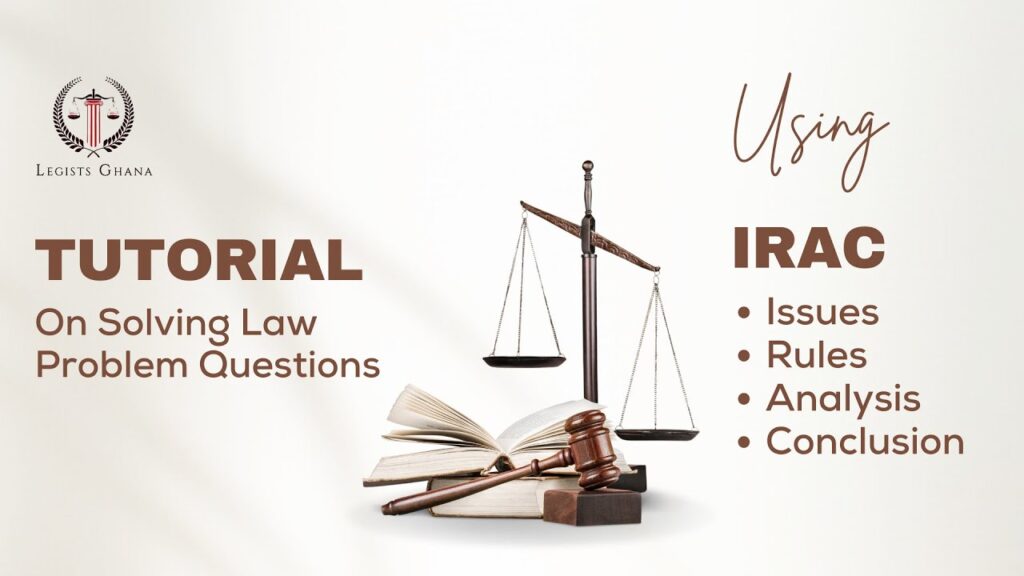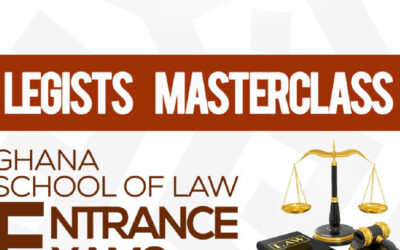
Contents
INTRODUCTION…………………………………………………………………………………………………………………. 1
1.0 IDENTIFYING A LAW PROBLEM QUESTION………………………………………………………………………….. 2
1.1. Five (5) Features of a Law Problem Question………………………………………………………………….. 3
2.0 PRELIMINARY READING OF A LAW PROBLEM QUESTION………………………………………………………. 3
3.0 BREAKDOWN OF IRAC…………………………………………………………………………………………………… 5
3.1 The Area of Law………………………………………………………………………………………………………… 5
3.2 The Issues………………………………………………………………………………………………………………… 6
3.3 Rules (Legal Principles and Authorities)………………………………………………………………………… 10
3.4 Analysis/Application…………………………………………………………………………………………………. 10
3.5 Conclusion and Advice……………………………………………………………………………………………… 11
INTRODUCTION
Many law students have problems with answering law problem questions. This is usually attributed to the unique structure that is regarded as the formal approach to raising legal issues, analyzing and applying the appropriate legal authorities.
This form is popularly referred to as the IRAC method and stands for:
Issues, Rules, Application and Analysis.
However, a contemporary IRAC format includes additional elements such as the “Area of Law” and “Advice”.
This law guide seeks to aid law students in properly answering law problem questions. It does not serve as legal advice or opinion of any form, and it is an independent work of Legists Legal Research Company.
Most of the content of this material was developed from the Legist Law Exam Masterclass Tutorials, a course designed to enable students adequately prepare for the Ghana School of Law Entrance Exams.
LEGISTS RESEARCH CONSULT LTD is a company dedicated to providing mentorship, academic aid and research support to anyone studying one law course or the other. If you are interested in legal research, academic support and training, kindly reach out to legistsghana@gmail.com or check out the website https://ghlegists.com.
1.0 IDENTIFYING A LAW PROBLEM QUESTION
A problem question is usually a set of facts that leads to a matter of contention or dispute between two or more parties. An essay question is usually an instruction to discuss or analyze a specific topic sentence. It can be to review a case or provide a legal opinion on a matter.
1.1. Five (5) Features of a Law Problem Question
- There is more than one party involved.
- There are a set of facts in a narrative or storyline format.
- There are matters in contention between the parties.
- You must usually advise a party on the matter.
- There is a legal forum involved such as a party looking to institute an action at the court or seeking a legal remedy.
2.0 PRELIMINARY READING OF A LAW PROBLEM QUESTION
- Find the parties. Name every natural or artificial person irrespective of whether they have a legal matter, whether they are your client to advise, or whether they are the accused or victim (criminal case).
Illustration 1: (Names and parties are made up to create problem questions.)
Kofi and Ama planned to have a date at the Kutuwi restaurant in Takoradi. At the restaurant, they were served a chilled drink by the waiter. Ama took a sip and realized the drink tasted a bit off. She spat it out thereby causing a scene at the restaurant. Joojo, a patron of the restaurant seated close to Ama decided to come to her aid. He poured out the drink and at its bottom was a decomposed snail. Ama intends to sue the restaurant for the shock and harm caused to her. She has come to you, a young practitioner for legal advice.
All the parties in this problem question are:
- Kofi (who accompanied Ama on the date).
- Ama (who took the drink and wants to sue because of the decomposed snail found a the bottom of the glass).
- The waiter (who served the drink to Ama at the restaurant).
- Kutuwi Restaurant (where the drink was served to Ama during the date).
- Joojo (a patron of the restaurant who aided Ama in discovering the snail at the bottom of the glass).
However, it is clear that not all the parties are relevant in this problem question.
- Identify the features and status quo of the parties.
Ask yourself:
Is it a natural or artificial party?
What is the relationship between the parties? Are they contractual parties, family relations, trustee-beneficiary, lessor-lessee etc.
Is the artificial party, newly incorporated or registered, or is it a private entity or a state entity?
Illustration 2.
With reference to the same problem question in Illustration 1, the relevant parties to the suit are actually:
- Ama is the plaintiff who intends to bring an action for negligence due to the decomposed snail found at the bottom of her drink.
- Kutuwi Restaurant. The Restaurant is the defendant that Ama intends to sue for their negligence.
Kofi is not a relevant party in solving this problem question. He merely accompanied Ama on a date. At best, he is simply a witness.
Joojo is not a relevant party in solving this problem question. He merely aided Ama in discovering the decomposed snail at the bottom of the drink. At best, he is simply a witness.
The waiter might be a relevant party but based on the principles of vicarious liability and negligence, Kutuwi restaurant is the probable defendant in this suit.
- Decide on the relevant facts.
Distinguish between facts that directly contribute towards creating the legal issue between the parties and facts that merely add up to the narrative.
Illustration 3.
With reference to Illustration 1, the relevant facts are that:
“Ama went to Kutuwi restaurant, was served a drink and discovered a decomposed snail at the bottom of the drink. She is seeking legal action”
The rest of the facts in the problem question, including why she was at the restaurant, the waiter and the patron are irrelevant in resolving the legal issues.
- List all authorities and legal references.
Take note of constitutional provisions, statutory law, subsidiary legislation, precedent, international treaties, customs and any other legal provision stated in the facts.
Illustration 4
In reference to Illustration 1, the general area of law is Negligence.
Therefore, the student must make references to authorities on negligence including authorities that establish:
- Duty of care owed to the plaintiff by the defendant.
- Breach of the duty of care.
- Damages suffered as a result of the breach of the duty of care.
- Decide the remedy the (aggrieved) party looks for.
Usually, at the end of the problem question, there will either be a clear statement of the remedy the aggrieved party wants, or you will be able to figure out the exact requirement of the legal counsel or the examinee.
Illustration 5
In reference to Illustration 4, the remedy that Ama seeks is most likely damages, financial compensation for the negligence that caused her shock or harm.
3.0 BREAKDOWN OF IRAC
IRAC is broken down into five main parts.
- The Area of law
- Relevant Issues
- Rules/Authorities
- Application/Analysis
- Conclusion/Advice
3.1 The Area of Law
The Area of law is the broader topic under which the specific issues in dispute between the parties arise.
There might be two or more broad topics, and some topics are quite common in problem questions such as:
- The Jurisdiction of the court.
- The Locus Standi of the party.
It is important not to select a broad or ambiguous area of law such as:
“The area of law is contract law.”
“The area of law is criminal liability.”
“The area of law is immovable property.”
Recommendation:
First, decide the issues that might arise between the parties and thereupon find the broad area by which the dispute falls under.
Illustration 6: (Please note illustrations are not full facts.)
In a criminal law question, the issues dealt with determining intent (mens rea)
The area of law is simply Mens Rea.
There is no need to say the area of law is “Criminal liability” as to prove liability there are two elements involved, and these are the Actus Reus and Mens Rea (intent). The question does not deal with actus reus but with establishing the requisite mens rea.
Illustration 7:
Where the question deals with a breach of contract, the area of law should not
“Discharge of contracts.” That is broad.
A contract can be discharged by breach, frustration, performance, and agreement.
Therefore, the area of law should simply be “breach of contract.”
Combination of Areas:
It is obvious that there can be two or more issues created by the facts. In such a scenario, you could simply state the areas of law.
It is rare for multiple areas of law to be under different classifications of law which are regarded as opposites:
Examples:
- Sale of Goods (Commercial law —movable property) and Leases (Land law —immovable property).
- Directors (company law) and Battery (Tort law)
- Homicide (criminal law) and Frustration of Contracts (Contract law)
Some areas of law interlink because broad classifications of law tend to overlap. The student must ascertain which area of law best fits the facts in question.
Example:
A set of facts on Trespass to Land can be related to the Right to Own and Privacy of Property under Constitutional Law.
The law student must read the facts clearly to ascertain the area of law.
3.2 The Issues
The issues are the matters in contention between the parties. Usually where one party asserts a claim, right, interest, privilege, or immunity, the other party may rely on a defense, counterclaim, exemption, justification, or challenge.
This creates a dispute that may be resolved by the court or a judicial body.
- How to Raise Relevant Issues.
- The matters of contention must be based on legal issues not factual issues.
Illustration 8: (Please note illustrations are not full facts.)
- A seller and buyer executed a contract for the sale of a car. However, the buyer refuses to pay because he claims that per the terms of the contract it was for a blue 2018 Nissan Altima, but the car sold was a silver 2012 Nissan Altima.
Wrong issues:
- “Whether or not the car, the subject matter of the contract was a blue Nissan car or silver Nissan car”
(The color of the car is already a fact —silver 2012 Nissan Altima)
- “Whether or not the make of the car was a 2012 or 2018 model”
(The make of the car is already a fact — 2012 model)
Correct issue:
- “Whether or not a reasonable objective man familiar with the facts, circumstances and terms of the contract will conclude that the parties entered into an agreement for a 2012 Nissan Altima”
Illustration 9
Kofi met Ama alongside the road and shoved her violently. He said it was a prank.
Issue: Whether Kofi made physical contact with Ama?
This is a wrong issue. Kofi did in fact make physical contact with Ama hence it is not something in dispute or contention.
Issue: Whether Ama consented to the prank?
This is a wrong issue. The facts make it clear that Ama obviously did not consent to physical contact. Kofi admitted it was a prank.
The main matter in contention is the state of mind of Kofi (the defendant).
“Whether his intention to commit a mere prank absolves him of liability?”
- Nine Tips on Constructing Legal Issues:
- The issue(s) must align with the area(s) of law. This means any issues that are not associated with the stated area of law are problematic and might have marks deducted.
- The issues must not be broad. The issues must be constructed specifically in relation to the stated facts in contention
- Frame the issues in the same manner that you read in court decisions especially. Read many court decisions as a guide.
The court decisions give a brief linkage between the action and the law.
Illustration 10:
- Whether the seizure of the properties was constitutional?
- Whether or not the seizure of the properties belonging to A without compensation was in breach of Article 20 of the 1992 constitution of Ghana?
Courts are likely to adopt the second issue.
- An issue is a matter in contention between two or more parties. Therefore, a set of facts agreed by both parties and confirmed as true cannot be an issue.
Illustration 11:
In Ghana, a person below the age of 21 years cannot be a Parliamentarian. The facts said the age of the candidate is 20 years.
- Whether or not the candidate is 20 years or 21 years?
- Whether or not the 20-year-old candidate is eligible to contest for parliamentary elections in Ghana?
The first issue is incorrect because it is already a fact and creates no room for legal analysis. The second issue is correct.
- Understand the distinction between factual parties and the disputing parties.
The actions of factual parties are relevant in creating the narrative, but they are not relevant in settling the dispute. They are “third parties” to the dispute. Disputing parties are parties with issues or matters in contention.
Common examples of contending parties are:
“The Plaintiff v The Defendant.”
“The Republic v The Accused.”
Refer to Illustration 1 and 2.
- The issue must be clear and straightforward. The issue must not be too detailed or lengthy with the facts or law.
Illustration 12
In reference to the facts contained in Illustration 1 a straightforward and valid issue will be:
“Whether or not Kutuwi restaurant is liable for negligence for serving a drink containing decomposed snail to their customer, Ama?” or “Whether Ama is entitled to claim damages against Kutuwi for negligence?”
A lengthy issue would contain too many details.
“Whether or not Ama as a customer on a date at Kutuwi restaurant, being served a drink upon her request and finding a decomposed snail at the bottom of the drink is entitled to bring an action (sue) Kutuwi restaurant for the tort of negligence specifically for the injury or shock caused to her.”
- Avoid repetition of issues by framing them in different manners or forms. If the two issues are substantially the same, you can merge both.
Illustration 13.
Referring to the facts in Illustration 1 and Illustration 12
“Whether or not Kutuwi restaurant is liable for negligence for serving a drink containing decomposed snail to their customer, Ama?”
And
“Whether Ama is entitled to claim damages against Kutuwi for negligence?”, are both similar issues. You can choose any or merge them into a single issue.
- Avoid refusing to raise relevant issues on the grounds that you don’t have enough time. It is better to raise all the relevant issues and rules and fail to do analysis than ignoring the issues which means that the applicable law in relation to the ignored issues will also be disregarded.
- Review your issues to ensure that they make sense and communicate coherent thoughts. You will have to ensure that the issues will lead to a breakdown of the applicable authorities
3.3 Rules (Legal Principles and Authorities)
The rules are the relevant provisions of law applicable to the problem questions. These provisions can be contained in constitutions, statutes, subsidiary legislation, ratio decidendi of related cases (judicial precedent), customs & usages, international conventions/treaties as well as principles or maxims of equity.
Legal Authorities include but are not limited to:
- The Constitution.
- Statutes (Acts of Parliament).
- Subsidiary legislation like Legislative Instruments, Constitutional Instruments and Executive Instruments
- Judicial precedent (case law)
- Equity
- Customary law
- Statutes include international treaties or conventions adopted by the Act of Parliament.
- Textbooks and articles.
Take note of the relevant hierarchy of law.
A judicial precedent or custom can’t override a statute. A subsequent statutory provision can override precedent or custom.
A statutory provision cannot override a constitutional provision.
You do not need to restate the entire provision of the law, rule or authority. It is recommended to summarize or shorten the provision to portray to principle you seek to apply. It is rare to write the full title of a case, judicial decision or statute. Every case, statute or formal law has a shortened title version which can be applied in an examination.
Illustration 14:
A landmark case on Negligence is the case of Donoghue v Stevenson.
There is no need to state: “Donoghue v Stevenson [1932] AC 562” unless it is a research article or assignment where full references are desired.
3.4 Analysis/Application
This is the application of the rules and authorities to the facts. The student/examinee does not need to repeat or rewrite the full authorities but may simply refer to statutory provisions, case law or any applicable law.
Illustration 15:
Referring to the facts in Illustration 1, referring to the case of Donoghue v Stevenson as binding precedent, the three elements of negligence known as, duty of care, breach of duty of care and damage suffered has been fulfilled.
3.5 Conclusion and Advice
The conclusion can be regarded as an expression of your final opinion on the issues which may include some advice to either one or more of the parties in the dispute.
Illustration 16
Referring to the facts of Illustration 1 and the applicable authorities, it is clear that Ama has a cause of action against Kutuwi restaurant for negligence and is entitled to sue for damages.
This is the general scope of the IRAC method in addressing law problem questions. The Issues simply raises the matters in contention between the parties. The Rules raise the relevant principles backed with statutes, cases (precedent), laws, customary rules, international treaties and customs, textbooks and articles by scholars. The Application is the analysis of the facts and issues of the problem question within the scope of the law to reach a coherent and legally acceptable conclusion. The Conclusion usually contains advice for the relevant party or parties.





